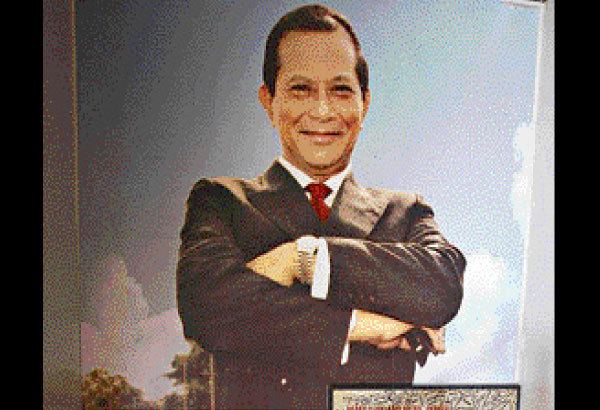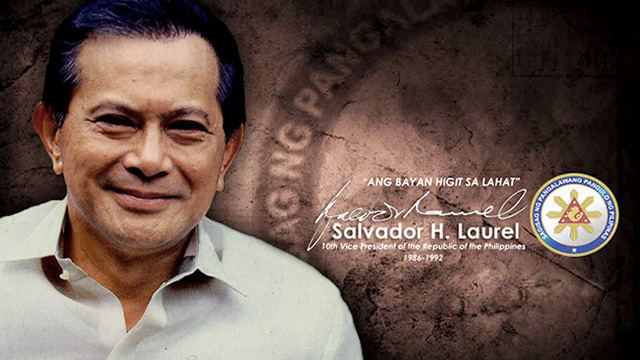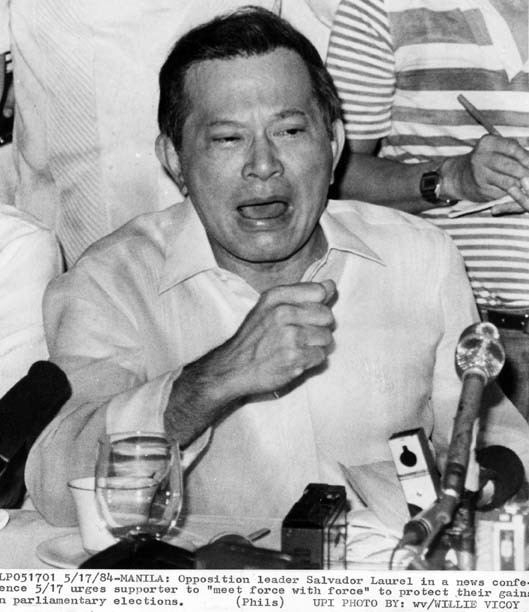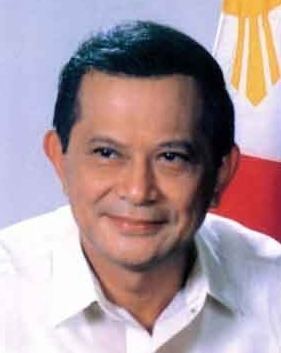Spouse Celia Diaz (m. 1950) Parents Jose P. Laurel | Name Salvador Laurel Preceded by Arturo Tolentino Succeeded by Position abolished | |
 | ||
Role Philippine Political leader Children Victor Laurel, Stella Laurel, Lawrence Laurel, Susana Laurel, Kris Laurel, David Laurel, Celine Laurel, Marissa Laurel Similar People Jose P Laurel, Sotero Laurel, Denise Laurel, Corazon Aquino, Jose Cojuangco | ||
G20118507
Salvador Roman Hidalgo Laurel (November 18, 1928 – January 27, 2004), also known as Doy Laurel, was a Filipino lawyer and politician who served as Vice-President of the Philippines from 1986 to 1992 under President Corazon Aquino and briefly served as Prime Minister from 25 February to 25 March 1986, when the position was abolished. He was a major leader of the United Nationalist Democratic Organization (UNIDO), the political party that helped topple the dictatorship of President Ferdinand Marcos with the 1986 People Power Revolution.
Contents
- G20118507
- President Reagan Meeting with Philippine Vice President Salvador on May 1 1986
- Early life
- Stay in Japan
- Return to Manila
- Legal career
- Senator
- Vice presidency and premiership
- Post vice presidency
- Later life and death
- References

President Reagan Meeting with Philippine Vice President Salvador on May 1, 1986
Early life

Laurel is the fifth son of President José P. Laurel of the Second Philippine Republic, a puppet state of Japan during the Second World War. He was born to a family whose illustrious lineage spans generations of nationalists who distinguished themselves as public servants. His grandfather, Judge Sotero Remoquillo Laurel, was both a delegate to the Malolos Congress in 1899 and Secretary of the Interior in the first Philippine revolutionary government under President Emilio Aguinaldo.

He first enrolled at Centro Escolar de Señoritas, studying there from 1933 to 1935. Laurel’s father wanted Laurel to experience a public school education and so enrolled him first in the Paco Elementary School (1935–36) and then the Justo Lukban Elementary School (1936–37). He finished elementary schooling at Ateneo de Manila Grade School in 1941. In his first year of high school, Laurel received second honors, with a general average of 93.4. Barely three months later, his studies came to an abrupt halt with the outbreak of the war in the Pacific Theater on 8 December 1941. The school was temporarily closed by the Japanese government as run by American Jesuits, which prompted Laurel to enrol at De La Salle College High School, where he graduated in 1946.

Laurel was a member of Upsilon Sigma Phi during his university studies.
Stay in Japan
Towards the end of the war, the Japanese Supreme Council of War issued an order to have officials of the Philippine government flown to Japan. President Laurel volunteered to go alone to spare his Cabinet members the ordeal of being separated from their families. His wife, Paciencia, and seven of his children went with him. Among the officials who accompanied him were Speaker Benigno Aquino, Sr., Minister of Education Camilo Osias and his wife, and General Mateo Capinpin. On 21 March 1945, the group began a long and perilous overland journey to Tuguegarao, where a Japanese navy plane would fly the group to Japan. The odyssey ended in Nara, where they were confined until 10 November 1945.
The long confinement gave the romantic and impressionable 15-year-old Salvador the luxury of time to write poetry and prose and satisfy his insatiable thirst for books. Whenever he was lucky to find an English book, he would read it voraciously and discuss it with his mentor, Camilo Osias. But his most treasured moments in Nara were those spent with his father, enjoying their daily morning walks in the park when José would discuss his views on life.
On 12 September 1945, José Laurel was arrested by a group of Americans headed by a Colonel Turner and was taken to Sugamo Prison. The Laurel family was flown to Manila two months later on 10 November 1945.
Return to Manila
Christmas 1945 was the bleakest one for the Laurel family; their Peñafrancia home was looted and emptied of its furniture, while the former President was placed in solitary confinement in Sugamo Prison in Japan. Salvador wrote the poem To My Beloved Father to lift up his father's spirits and sent it to him as a Christmas present.
At La Salle, he joined a group of young men who planned to go by sea to the Dutch East Indies (Indonesia since 1949) and join Sukarno in the struggle for independence from the Dutch Empire, but local authorities stopped them at the pier. He completed his secondary education at La Salle in March 1946.
Although all his older brothers were lawyers, he enrolled at the University of the Philippines as a premedicine student, where he obtained his AA (premdicine) and was admitted to medicine proper, shifting to law two years later. He was admitted to the law school while working to complete his (AA Pre-Law). He received his LLB (Bachelor of Laws), degree in UP in March 1952.
He was acclaimed the University Champion Orator after he won the first prize in three consecutive inter-university oratorical contests: the 1949 Inter-University Oratorical contest sponsored by the Civil Liberties Union (CLU); the Student Councils Association of the Philippines (SCAP) and the Inter-University Symposium on the Japanese Peace Treaty in 1951.
Without waiting for the results of the bar examination, he left for Connecticut to study at Yale University, his father’s alma mater where he earned his Master of Laws degree (LL.M.) in 1953. He earned the title Doctor of Juridical Science (J.S.D.) at Yale University in 1960.
Of his studies and scholastic endeavors at Yale University, Myres S. McDougal, a Sterling Professor of Law, Emeritus of the Yale Law School, wrote:
Laurel later married Celia Díaz, a society debutante.
Legal career
In Manila, Laurel joined his brothers in the Laurel Law Offices in Intramuros. During his early years as a barrister, he became deeply involved with legal aid. He was appalled to discover that 94% of the cases filed by indigents in the fiscal’s office were dismissed for lack of counsel. This led him to found Citizen’s Legal Aid Society of the Philippines (CLASP).
He campaigned throughout the country, convincing lawyers to join him in his quest for justice for the poor, and by the end of that first year, 750 lawyers had joined CLASP. In 1976, the International Bar Association honored him with the "Most Outstanding Legal Aid Lawyer of the World" award in Stockholm.
In 1960, Laurel edited the papers of the convention that drafted the 1935 Constitution, compressing 24 tomes of documents into seven compact volumes. It was in fulfilment of a promise he had made to his father, who was originally to collaborate in the project but died prematurely of a cerebral haemorrhage, in 1959.
Senator
It was not until 1967 that Laurel seriously entered politics, when he won a Senate seat in the 6th Congress. The youngest Nacionalista senator, Laurel was named the most outstanding senator from 1968 to 1971. When he won in 1967, Laurel had run ran for the Senate to continue his crusade for justice for the poor. He emerged victorious as the youngest Nacionalista elected senator, and a distinguished public service career, spanning nearly 37 years, began.
In his first year as senator, he was Chairman of the Senate Committee on Justice, Committee on Economic Affairs, Committee on Government Reorganization, and Committee on Community Development. He authored five "Justice for the Poor Laws" known as the "Laurel Laws," nine laws on Judicial Reforms (1968–1970); the Government Reorganization Act (1968–1970) and Amendments to the Land Reform Code (1971). He also wrote a book on penal reforms and another on land reform, "This Land Is Mine." He was consistently voted “Most Outstanding Senator of the Year” in 1968, 1969, 1970, and 1971.
In 1972, Laurel was the first Philippine government official to visit the People's Republic of China, then under Chairman Mao Zedong. He was met by Premier Zhou Enlai, Vice Premier (later President) Li Xinnian, and other high officials of the Chinese government. Upon his return, he submitted an extensive report to the Senate on his China visit. He strongly advocated for the resumption of friendly ties with the PRC and the adoption of the One-China Policy, which eventually became the official stand of the Philippines.
Vice-presidency and premiership
For a brief period following the People Power Revolution in late February 1986, Laurel became the only person in Philippine history to hold the posts of Vice-President, Prime Minister, and Foreign Minister concurrently. The office of Prime Minister was abolished in late March 1986, and Laurel was replaced as Secretary of Foreign Affair by Raul Manglapus in 1987.
He ran for president in the 1992 elections as the head of the Nacionalista Party. However, he failed to gain Aquino's support and so lost to her favoured successor, Fidel V. Ramos.
Post-vice presidency
In 1996, he was appointed by President Ramos as the chairman of the Philippine National Centennial Commission in the run-up to the Philippine Centennial of the country's independence on 12 June 1898. Through his unwavering leadership, he revived Filipino nationalism by promoting Filipino heritage and culture with heavy advertising.
He was supposed to resign after the Centennial celebrations, but President Joseph Estrada extended his term and abolished the Commission only in 1999. A few months after, Laurel was charged with graft before the Sandiganbayan (political antigraft court) for misappropriating funds for constructing of the controversial, ₱1.165-billion Centennial Expo in Clark Freeport Zone in Angeles City, Pampanga. Laurel vehemently denied the allegation and chose to stand as his own defense counsel.
Later life and death
He returned to private life and spent most of his retirement in the United States. He contracted lymphoma and died of the same ailment on 27 January 2004, in Atherton, California. His remains were cremated days afterward, with his ashes interred at the Libingan ng mga Bayani.
On 29 January, President Gloria Macapagal-Arroyo issued Presidential Proclamation № 544, declaring several days of official mourning for Laurel.
